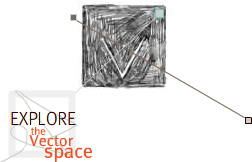The RED Project
Rendering Electromagnetic Distributions
Editor's Introduction
The title of Christian Sandvig's The Red Project refers provocatively to the once-common practice of "redlining," by which American mortgage companies refused to invest in predominantly minority-owned neighborhoods in urban areas. For more than 30 years, this practice, which was "good business" to some and overt racism to others, helped cement economic and racial segregation as a nearly intractable feature of American cities. A historical investigation of the era when redlining went largely unchallenged (roughly 1934-1968) yields a wealth of damning evidence, particularly maps of cities where minority neighborhoods are designated as "declining" or "hazardous" and colored bright red. Sandvig cleverly inverts this historical convention by obscuring those areas whose demographics predict the highest concentration of wifi networks (calculated by a combination of race, age, economics, education and population density) in a bright red haze.
Maps, as Francois Bar reminds us in the peer response to The Red Project, function as powerful metaphors that can shape or constrain the thinking of policy makers and government officials as well as the public at large. Geographer Bernard Nietschmann stated it even more bluntly, "Maps are power. You either will map or you will be mapped." The Red Project stages a mashup of two powerful epistemes represented by the high-tech satellite imaging of Yahoo Maps and demographic data mined from the U.S. Government's Census Bureau. Sandvig strikes a delicate balance between these two ways of viewing/quantifying the world and its inhabitants by creating a tool that does not fully embrace either system. Users of the Red Project are presented not with an indexical rendering of actual wifi signals (as if such a thing were possible!), but with a prediction engine which invites speculation, interpretation and resistance. Sandvig's project thus resists the temptation to simply replace one cartographic and epistemological regime with another, opting instead for an analytical tool that invites reflection on systems of knowledge, power and representation.



